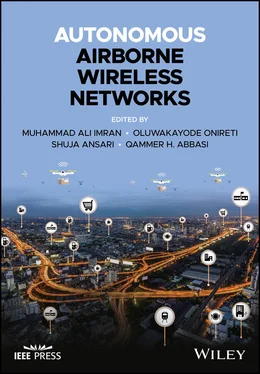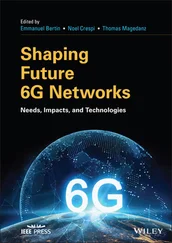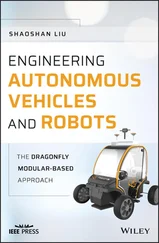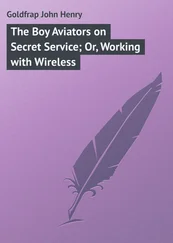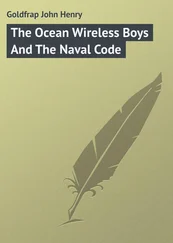Geometrical analysis, numerical simulations, and empirical data are used to obtain the stochastic fading models [38–40]. Geometry‐based stochastic channel model (GBSCM) is the most popular type of small‐scale fading model. GBSCM is subdivided into regular‐shaped geometry‐based stochastic channel model (RS‐GBSCM) and irregular‐shaped geometry‐based stochastic channel model (IS‐GBSCM). Time‐variant IS‐GBSCM was presented in [41] and RS‐GBSCM was presented in [42] and [43].These works illustrated Rician distribution for small‐scale fading. In [44], non‐geometric stochastic channel model (NGSCM) was provided, where small‐scale effects of AG propagation were modeled by using Rician and Loo models. Table 2.3provides the measured characteristics of small‐scale fading of AG propagation in different environments.
Table 2.3 Measured small‐scale fading of AG propagation in different environments.
| References |
Scenario |
Frequency band |
Fading distribution |
| Khawaja et al. [11] |
Suburban/Open field |
Ultra‐wideband |
Nakagami |
| Newhall et al. [12] |
Urban/Suburban |
Wideband |
Rayleigh, Rician |
| Tu and Shimamoto [13] |
Urban/Suburban |
Wideband |
Rician |
| Matolak and Sun [14] |
Urban/Suburban |
Wideband |
Rician |
| Simunek et al. [45] |
Urban/Suburban |
Narrowband |
Rician |
| Cid et al. [46] |
Forest/Foliage |
Ultra‐wideband |
Rician, Nakagami |
| Matolak and Sun [47] |
Sea/Fresh water |
Wideband |
Rician |
2.4.1.3 Airframe Shadowing
Airframe shadowing occurs when the LoS of AG propagation is obstructed by the UAV structure. This impairment is unique to UAV communications for both AA and AG channels and does not exist in conventional cellular communications. Airframe shadowing is more severe in fixed‐wing UAVs mounted with single antenna. In this case, the AG communication link can be severe during roll, pitch, or yaw motion of the UAV. One possible solution to alleviate airframe shadowing is to replace the single‐antenna system with spatially separated multiple antennas. Other factors responsible for airframe shadowing are the size, shape, and material of the UAV. The seminal work on the measurement of airframe shadowing was performed in [48], which found that the aircraft roll angle was proportional to the shadowing attenuation. Moreover, shadowing duration depends on the flight maneuvering.
2.5 Key Research Challenges of UAV‐Enabled Wireless Network
This section discusses some of the key research challenges for the practical deployment of UAVs as airborne wireless nodes.
2.5.1 Optimal Deployment of UAVs
In UAV‐based communications, one of the key challenges is the optimal three‐dimensional deployment of hovering UAV. The capability of UAV to maneuver and adjust its altitude provides additional degree of freedom for UAV deployment in an efficient manner to improve capacity and coverage. In fact, UAV deployment is more challenging in UAV communications than in conventional terrestrial communications because the characteristics of AG propagation change with the position of the UAV. However, for efficient UAV deployment, flight duration and energy constraints must be taken into account for battery‐operated UAV, as they affect the performance of networks. In addition, simultaneous deployment of multiple UAVs is more challenging because of the co‐channel interference and the possibility of airborne collision of UAVs. Another important issue is the UAV deployment in the presence of terrestrial network. UAV deployment problem has been extensively discussed in the literature for coverage maximization 17,29,30,33,33, data collection from Internet of Things (IoT) devices [31], UAV‐assisted wireless network [27], disaster scenario [49], and caching applications [22].
2.5.2 UAV Trajectory Optimization
Optimal trajectory design for mobile UAV is an important issue in UAV‐based communications. Specifically, optimal path planning is crucial for UAVs operating for data collection from ground‐based sensors and caching scenarios. UAV trajectory planning is mostly effected by the dimension of the target area, flight duration of the mission, QoS requirement by the ground users, and energy constraints. Apart from physical parameters, UAV trajectory optimization is analytically a challenging problem because it involves a fixed number of optimization variables related to the UAV locations [1]. In addition, UAV trajectory optimization requires coupling between different QoS metrics in wireless communication with the mobility of UAV. Recently, there have been a number of studies on the joint trajectory optimization of UAV with its wireless communication metrics, such as throughput maximization in [50–52] and energy‐efficient UAV communication in [53,54].
2.5.3 Energy Efficiency and Resource Management
Energy efficiency and resource management require attention where UAVs are operating in key scenarios to collect data from IoT devices, ensure public safety, and support cellular wireless network. Resource management is a major challenge in UAV communications unlike in cellular communications [55]. However, UAV communications introduce additional hindrance in radio resource management due to the interplay between the UAV flight duration, mobility pattern, limited energy source, and spectral efficiency. Therefore, in [56], resource management was jointly optimized with the UAV trajectory in wireless environment.
Limited amount of on‐board energy is available for battery‐operated UAV, which must be used for propulsion and to fulfill communication‐related tasks [5]. Consequently, continuous and long‐term wireless coverage curtails the UAV flight time. In addition, UAV energy consumption also depends on its path, weather condition, and mission of the UAV. Thus, energy constraints of UAV must be explicitly taken into account during planning of the UAV‐based communication systems. Various works have studied the interplay between energy efficiency and the optimal UAV trajectory [53–55].
This chapter discussed the use of UAVs in wireless communication network, specifically, the use of UAVs as aerial BSs and as aerial UE in cellular‐assisted systems. In both cases, the accurate channel model of the AG and AA propagation is paramount, which must take into account the environmental conditions, wireless channel impairments, and the UAV mobility to characterize the performance of UAV‐based communication network. Some channel modeling efforts have been studied in this chapter. In addition, key challenges, such as optimal deployment of UAVs, optimization of trajectory path, resource management, and energy efficiency, have also been highlighted.
1 1 Zeng, Y., Zhang, R., and Lim, T.J. (2016). Wireless communications with unmanned aerial vehicles: opportunities and challenges. IEEE Communications Magazine 54 (5): 36–42.
2 2 Qualcomm Technologies Inc. (2016). Leading the World to 5G: Evolving Cellular Technologies for Safer Drone Operation. Technical report. Qualcomm.
3 3 Patterson, T. (2015). Google, Facebook, SpaceX, OneWeb plan to beam internet everywhere. https://edition.cnn.com/2015/10/30/tech/pioneers-google-facebook-spacex-oneweb-satellite-drone-balloon-internet/index.html(accessed 08 March 2021).
4 4 Al‐Hourani, A., Kandeepan, S., and Jamalipour, A. (2014). Modeling air‐to‐ground path loss for low altitude platforms in urban environments. 2014 IEEE Global Communications Conference, pp. 2898–2904.
Читать дальше
